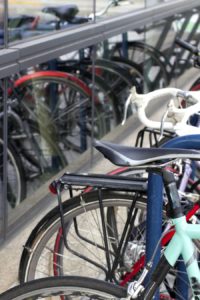 Buying a bicycle is a big decision. They don’t come cheap even at the lower end of the market, and so making sure that you pick the right one first time is pretty important.
Buying a bicycle is a big decision. They don’t come cheap even at the lower end of the market, and so making sure that you pick the right one first time is pretty important.
There are so many different types of bicycles out there, and deciding which one is right for you can be mind boggling. This article will help you break down that decision and narrow your options to help you make an informed decision on which bicycle is best for you.
As there are so many things to consider, I’ve broken the information down into 3 different sections:
- What to Consider – We will discuss some of the questions that you need to ask yourself before you can decide which type of bike you need. This secton will give you a guide to what kinds of things you need to think about when choosing a bike to buy.
- Types of Bikes – We will go into the main categories of bikes, what they typically feature, and who they are suited to.
- Features – After picking the type of bike, you need to work out what kind of features you need. Every bike will have different features that are suited to different needs.
- Sizing – The size of bike you get is just as important as the bike you choose. After you decide on your bicycle, it’s all about making sure it fits you perfectly.
By the end of this article you should know enough to make an informed decision about choosing your perfect bike!
Let’s get started….
What to Consider When Choosing a Bike…
First of all, it might help if you make notes on the answers to some of these questions so you can clearly have a list of your criteria at the end of it.
Here’s a break down of all the questions you need to be asking yourself when looking for a bicycle….
Where will I be Riding my Bike?
This will be one of the main factors that determine which type of bike you need.
Will you be riding on rough terrain, smooth pavements, or a bit of of both?
Is it going to be in hilly areas or mostly level ground?
This will determine what kind of gears and tires you need. (more details below in the ‘gears’ and ‘tires’ section)
What Will you be Using the Bike For?
Will you be using your bike for running quick errands and spur of the moment trips?
Are you a hobby cyclist going on speedy pursuits with a few friends?
Are you commuting to work on your bike in traffic conditions?
This will determine what kind of position you want to sit in when cycling, either upright or lower down, and also what kind of added extras you need your bike to fitted with. (more details later…)
What is the Maximum Amount I need to Carry during my Rides?
Do you need enough space to fit your your weekly grocery shop?
Are you going for a long cycling ride with friends and need supplies for your trip?
Do you want to carry as little as possible when cycling because you want to work on cycling at speed for a good cardio workout?
These question will determine how heavy or lightweight you need your bike to be and how much potential there is for it to carry saddlebags, racks, etc.
What Kind of Rider are You?
Do you like to ride at a leisurely pace and enjoy the scenery, or cycle at speed?
This will determine what kind of handlebars and bike frame you have, as it will affect what position you sit in when you ride.
What will I be Wearing on my Rides?
Do you like to get kitted out in full cycling gear when you ride or will you be cycling in your everyday clothes?
This will determine if you want your bike frame to be a dropped frame or not (see frame section below), and what kind of saddle and handlebars you go for.
How will I be Storing my Bike?
Will your bike be stored outdoors or indoors?
If it is outdoors, will it be covered or protected from the weather elements?
Do you need to lift it up every time you put it away?
This will determine how ‘liftable’ your bike is; how lightweight it needs to be. You will also need to bear in mind the material of your bike frame and how likely it is to rust if left outdoors.
What Conditions will I be Riding in?
Will you be riding in all weather conditions or just in the dry sunny weather?
Will it be off road or on smooth flat pavement?
This will determine what kind of tires you have (see ‘tires’ and ‘wheels’ section below)
What is my Budget?
The budget for the bicycle should be a secondary question. First decide which type of bike is best, and then look at how much you want to spend, as every type of bike will have a range of prices to choose from.
So…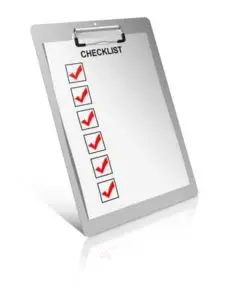
Decide from the above criteria which factors are absolutely necessary, and which you are willing to compromise on.
For example, speed, and the fun of the ride may be less of a priority because although you like to go fast, you can compromise if it means you have the practicality of having somewhere to store all your things during the ride.
Draw up a list of your non-negotiable features and your ‘nice to haves’.
Next we have a guide to the different bike options. Under each type of bike we have a quick summary, and then a list of…
- Features
- Pros and cons
- Who the bike would be ideal for…
Types of Bikes – Which Type of Bicycle Do I Need?
There are 3 main categories of bicycles:
- Road Bikes
- Mountain Bikes
- Hybrid Bikes
Road Bikes
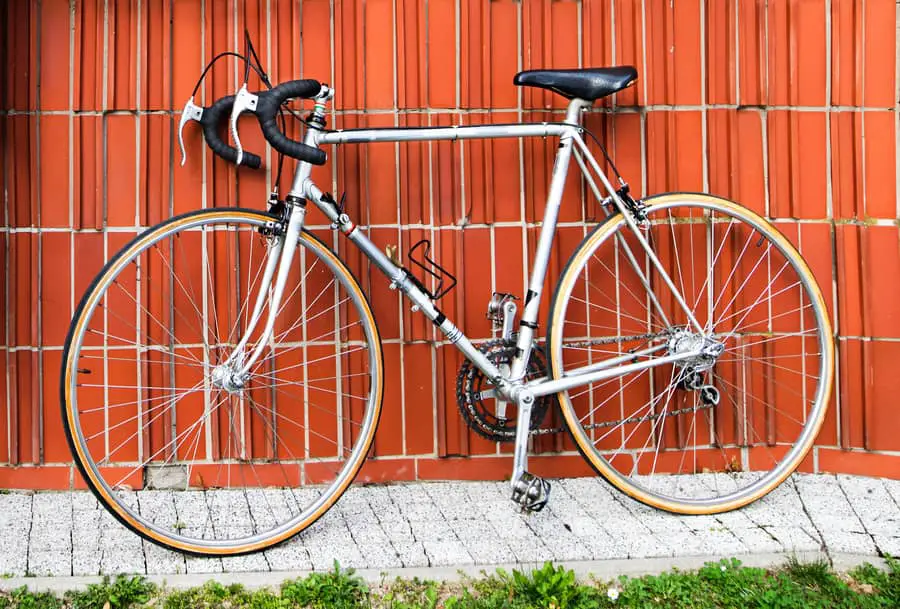 These bikes are designed to be fast, fun and sporty, and to be ridden on smooth, flat road surfaces and pavements. The tires are smooth and thin which make for very efficient cycling and they are very lightweight, with narrow lightweight saddles.
These bikes are designed to be fast, fun and sporty, and to be ridden on smooth, flat road surfaces and pavements. The tires are smooth and thin which make for very efficient cycling and they are very lightweight, with narrow lightweight saddles.
Road bikes are also designed to be ridden in a lower down ‘racer like’ position, as this is the most aerodynamic position to ride in.
Features of a Road Bike:
- Thin, smooth, skinny wheels with less grip/tread – This means fast efficient cycling on smooth flat surfaces, but also means they don’t fare too well going uphill or on rougher surfaces or wet muddy conditions.
- 700cc wheels – This is the standard adult sized wheel which makes for efficient cycling.
- Drop handlebars for a lower riding position – This is a more aerodynamic position for cycling at speed.
- Narrow saddle – designed for speed, not comfort.
- Made out of aluminium (if it’s at the cheaper end of the market) or carbon fiber (more expensive) – This makes the bike nice and lightweight.
- Gearing is highest and narrowest – This range is better for flat surfaces or downhill, and gives you more control at faster speeds.
- Low center of gravity and quick reaction for the rider – This is good for fast turning and is very responsive.
Advantages of a Road Bike:
- Fun to ride
- Fast efficient cycling
- Very responsive i.e. it reacts very quickly to the riders actions.
- Lightweight, so easier to lift and carry if needs be.
Disadvantages of a Road Bike:
- Not very comfortable on uneven surfaces or off road; as the tires don’t have much grip and are very narrow.
- Not very good at travelling uphill; as it doesn’t have very low gears.
- Usually able to carry very little as it is so lightweight.
- Not so good in wet weather conditions; as tires don’t have a lot of grip.
Road Bikes are Ideal for:
- Hobby cyclist riding on flat smooth rides with dry weather conditions.
- People who like to cycle fast and in a lower down racer type position.
- The commuter who likes to get to work quickly and doesn’t have much to carry (as long as your commute doesn’t have hills or rough terrain).
Mountain Bikes
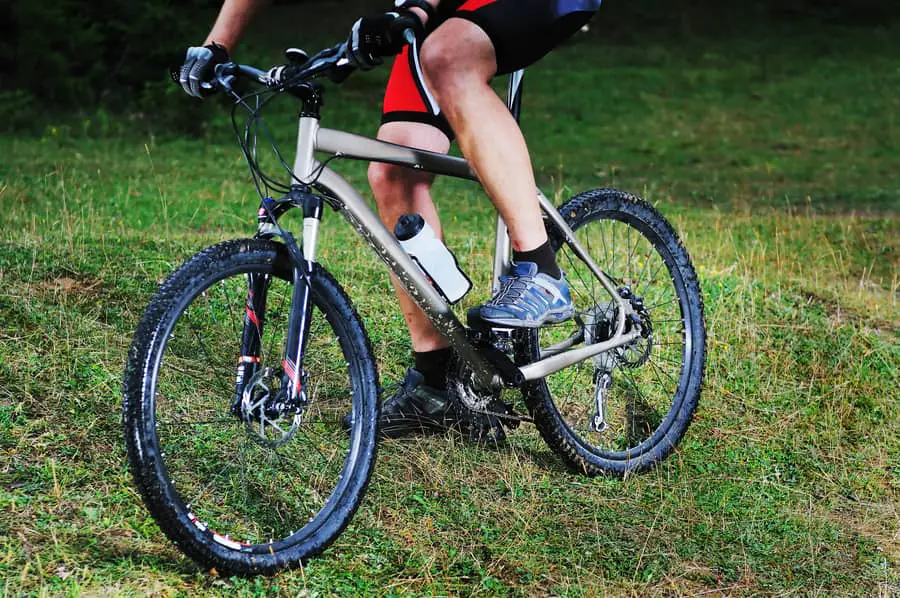 These bikes are designed to give you excellent control at slower speeds and work well off road, or in muddy wet conditions. They have thicker tires with much more grip and are fitted with shock absorbers or suspension, so they are much more comfortable on bumpy surfaces.
These bikes are designed to give you excellent control at slower speeds and work well off road, or in muddy wet conditions. They have thicker tires with much more grip and are fitted with shock absorbers or suspension, so they are much more comfortable on bumpy surfaces.
They are designed to be sat on in an upright position with flat handlebars, and have a lower gear range, so are good for pedaling uphill. Mountain bikes are heavy and have 3 different wheel sizes, usually going smaller than the standard adult sized road bike.
Features of a Mountain Bike:
- Thick knobbly tires with excellent grip – Good for wet weather conditions, rough terrain, gravel, etc.
- 3 different wheel size variations – The smaller the wheel, the more maneuverability you have.
- Flat handlebars – giving you an upright position.
- Fitted with shock absorbing features such as suspension – This means the ride will be more comfortable over rocky/bumpy surfaces.
- Heavier bikes – This gives better control in muddier conditons and slower speeds (but also bear this in mind if you need to lift it to store away regularly).
Advantages of a Mountain Bike:
- Excellent control and maneuverability, especially in tight spaces.
- Excellent for going uphill or travelling on rough terrain
- Good for wet weather conditions and muddy areas
- It’s heavier frame means it is able to carry heavier loads much more easily. Good for if you need to carry a lot with you when you cycle.
Disadvantages of a Mountain Bike:
- Not very efficient if riding on smooth surfaces or pavements; you will be having to put more work into pedaling when riding on smooth ground as you are working against the additional friction from the tires and the heavier weight of the bike.
- The weight might be an issue if you need to lift your bike to store it away regularly.
Mountain Bikes are Ideal for:
- Riding on rough terrain, gravel, off road
- Hilly areas
- Wet or muddy weather conditions
- Rides where you need to carry alot with you
Hybrid Bikes
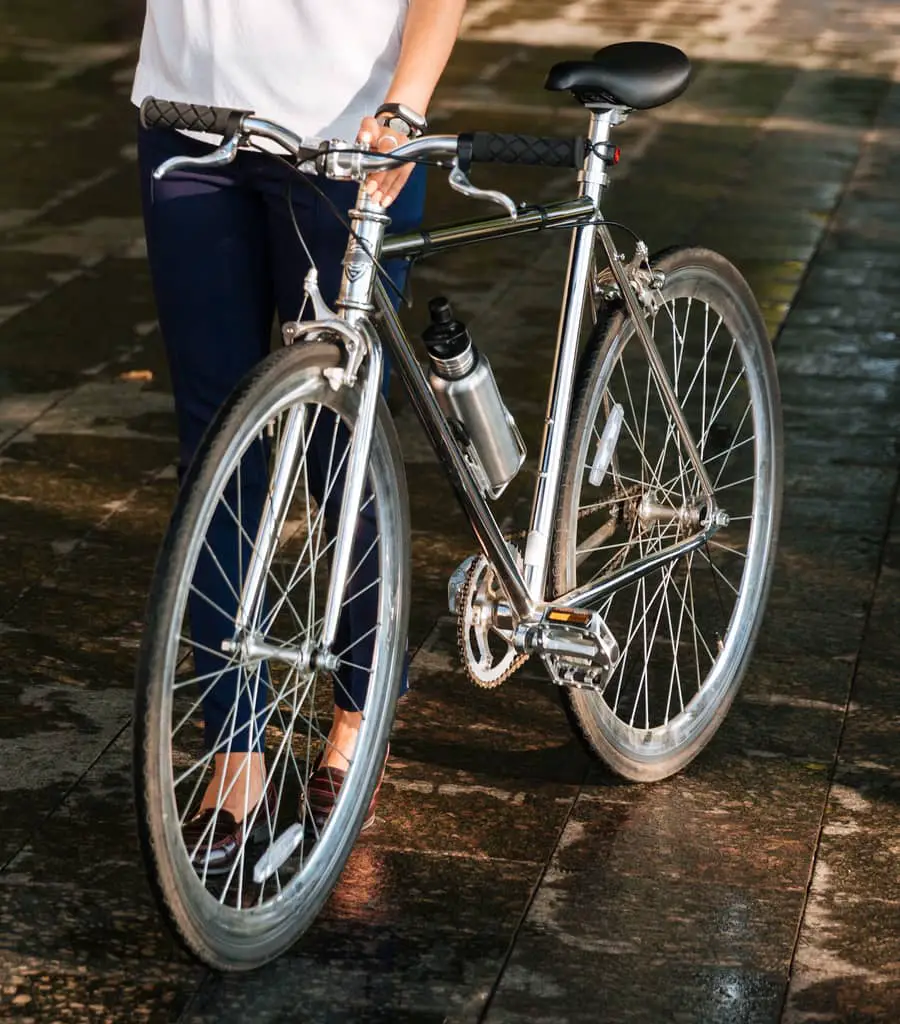 These bikes are the most versatile. They are a cross between a road bike and a mountain bike.
These bikes are the most versatile. They are a cross between a road bike and a mountain bike.
They have lightweight frames and large standard adult sized wheels. The tires are a cross between road and mountain bike tires; They have medium width and some grip, but are not as wide and knobbly as mountain bike tires.
These bikes are a good all rounder for riding on paved or unpaved trails.
They tend to also be kitted out with lots of practical features, such as places to fit mudguards, chain guards and panniers, and usually have reflective qualities for safer cycling around the city.
The saddles are usually large, padded and comfortable, and the bike is designed to ride in an upright position.
Features of a Hybrid Bike:
- Standard adult sized wheels – This means they are faster than mountain bikes on flat smooth surfaces.
- Usually made from aluminium – Making it lightweight and strong.
- Wide padded saddle – Making more comfortable riding, suited especially for cyclists who don’t kit out in cycling gear for every ride.
- Flat handlebars – This gives you an upright cycling position.
- Comes with lots of add on features – The bike usually has alot of features that enable practicality. For example brackets for fenders/mudguards, reflective lights on wheels, pannier racks/baskets, etc.
Advantages of a Hybrid Bike:
- They are faster and more efficient around paved trails than mountain bikes due to the larger wheels and slighlty less grip.
- They are very versatile – Excellent for rides where you encounter a range of riding surfaces.
- Can be fitted with mudguards/fenders and chain guards, or some already have these fitted, making them excellent for riding in your everyday clothes.
- Can be fitted with pannier racks, or sometimes have a basket at the front, making it suitable for carrying loads.
- The tires give you a good balance between riding in different terrains – They perform well in smooth flat areas as well as rough terrain and uphill.
- The upright cycling position is ideal for giving you good line of sight when cycling with other road users.
Disadvantages of a Hybrid Bike:
- They won’t go as fast as a road bikes on smooth flat surfaces
- Less maneuverability than a mountain bike
Hybrid Bikes are Ideal For:
- Using on a variety of riding surfaces.
- Casual riding such as running errands, grocery shopping, etc.
- People who like to cycle without the fuss of getting changed into cycling gear.
- Commuting in a range of weather conditions.
- Urban or city cycling.
- Commuting in traffic conditions.
Bicycle Features and Parts
Although each type of bike will tend to have similar features, it is important to understand what the different components of the bike are for and how they affect your ride.
This will help you understand exactly which bike is right for you, and if needed, what part of the bike you would like upgraded to suit you best.
Here we will go into the different features and their purpose to help you narrow down your perfect choice of bike. There is a small summary at the end of each section as a quick guide.
Types of Bicycle Handlebars: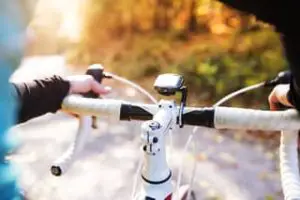
There are 4 main types of handlebars:
Flat – These can usually be found on mountain and hybrid bikes. They are, as the name suggests, flat all the way across, allowing you sit in an upright position, giving you good visibility when cycling.
Drop – These can usually be found on road bikes. The handles are ‘dropped down’, meaning you are holding them below the top of the bar, allowing you to be seated in a lower down position. This position is aerodynamic and is more comfortable when riding at higher speeds.
Their shape does allow you go to into different riding positions (there are several different places that you can hold the bars to adjust your position), but generally they are used for giving you that aerodynamic low down racing position, and their light weight design also allows you to get that extra bit of speed.
Mustache – These look a bit like a ‘mustache’ unsurprisingly! They are similar to drop handlebars but with very little drop. They allow you to sit in a more upright position than a drop handlebar, and are found on some hybrid bikes.
Riser – These are usually found on mountain bikes. They allow you to ride in an upright position, giving you good visibility of the road road ahead and excellent control.
In Summary:
- The handlebars affect the position in which you ride in.
- Having an upright position allows you to see around much more efficiently.
- Having a lower down position allows you to ride at faster speeds.
Types of Bike Frames
Firstly, bike frames are usually made out of either of these 3 materials:
Aluminium – This is lightweight, and doesn’t rust but it won’t last as long as other materials such as steel.
Steel – This is the traditional bike frame material. It is very durable and strong, and will last an extremely long time if looked after, but it is susceptible to rust, and tends to be quite heavy.
Carbon fiber – This is extremely lightweight, durable and strong but the disadvantage is that it can be very expensive.
 The frame shape is also something you should pay attention to…
The frame shape is also something you should pay attention to…
Normal frame – This is the average frame that has the top bar pretty much horizontal.
Dropped frame – The top bar of the bike frame is not horizontal, but ‘dropped‘ at an angle. This allows easier ‘hop on and hop off’ your bike, and is suited to people riding when they are wearing everyday clothes such as skirts or long coats.
People using cycling for errands and such, in everyday clothes may want to consider purchasing a bicycle with a dropped frame.
In Summary:
- Steel frames are heavy, but strong and long lasting.
- Aluminium frames are lighter, but won’t last as long.
- Carbon fibre is light, strong and durable, but very expensive.
- Dropped frames are designed for people who are not so tall, or who want to ride in everyday clothes including skirts.
Types of Bike Wheels
A standard sized wheel for an adult bike (called 700cc) is usually found on hybrid and road bikes.
This wheel size actually makes the most efficient ride. Each turn of the pedal will make you go the furthest with this wheel size.
The smaller wheel sizes come more so in mountain bikes, usually a range of about 3 different sizes.
The smaller size actually gives you more control at the finer level when riding slowly, as you can maneuver about much more finely with smaller wheels.
If you have a lot of very sharp turns, or make alot of U turns on your routes, then opting for smaller wheels might be a good idea.
In Summary:
- Bigger wheel sizes, such as the standard adult wheel size gives you the most efficient cycling.
- The smaller the wheel size after that, the less efficient the cycling, but the more maneuverability and control you have when turning in tight spaces.
- Smaller wheel sizes are usually found on mountain bikes.
Types of Bike Tires
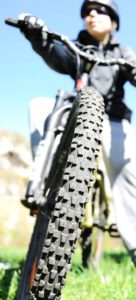 Tires come in all sorts of widths, thicknesses and treads (or ‘knobbliness’!). Let’s go into the purpose of each component…
Tires come in all sorts of widths, thicknesses and treads (or ‘knobbliness’!). Let’s go into the purpose of each component…
Grip/Tread/Knobblyness – The more grip it has, the more able it is to handle rough terrain, muddy wet surfaces etc, but the slower the bike will be (as you will have a lot more drag to go against when pedaling).
Width – The wider the tire, the more contact it has with the ground. This again means that you get more grip, but less efficient riding.
Tip: You can of course adjust the amount of air in the tire to take account what kind of grip you need. If you have fairly thin smooth tires, but are going on a long wet ride, reducing your tires air slightly will gve you slightly more contact with the ground; essentially making your tire slightly wider, and this will give you that little bit of extra grip when you need it.
In Summary:
- The wider the tire, the harder you need to push to cycle, but the more grip you have.
- The more knobbly the tire, the better grip you have, but the less efficient your cycling will be.
- The thinner and smoother the tire, the further you are able to go per pedal cycle.
About Bicycle Gears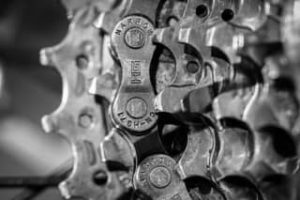
Gears on a bike are needed to give the bike more or less power as you are riding on different inclines or terrains.
Nowadays, bikes are commonly kitted out with either 18, 21, 24 or 27 gears. Although more gears give you more versatility, more gears also weigh down your bike a fair bit.
Low gears will help you when going uphill, and that is why mountain bikes have these.
High gears help you to have more control when going downhill.
You can buy single speed bikes that have no gears at all. It is hard work going up hill but these are extremely easy to maintain as not a lot can go wrong with them, and they will of course also be very lightweight.
In Summary:
- If you need help going uphill on your rides, make sure you buy a bike that has lower gears.
- If you are travelling mostly flat surfaces, downhill, or are pretty fit and don’t need help going uphill, you can go for higher ranging gears, or even no gears at all.
- The more gears you have, the heavier the bike will be.
Types of Bicycle Brakes
There are 3 main different types of brakes and they all have their pros and cons:
Disk brakes – These brakes work by gripping the brake pads onto a brake rotor on the wheel hub. (the centre of the wheel).
Because the brake pads are in the middle of the wheel, as opposed to the rim, they are away from the ground, leaving them nice and dry and protected from grit, which means they perform well in wet terrain. You will find them most commonly on mountain bikes.
Pros of Disk Brakes:
- Really good performance in steep or wet terrain.
- Braking is more consistent
- There is less strain on your fingers.
Cons of Disk Brakes:
- More difficult to check and replace the brake pads
- Tend to be more expensive to service
Rim Brakes – These are the most common type of brake you will find.
They are the brakes that work by gripping onto the rim of the wheel (The edge the wheel right next to the tire).
These brakes are in contact with more grit and mud being on the rim, which is close to the ground, and so will not perform as well in wet or muddy conditions.
Pros of Rim Brakes:
- Easy to check brake pad wear
- Easy to replace.
Cons of Rim Brakes:
- The wheel rim eventually wears out, needing wheel replacement.
- Less effective stopping power than disk brakes
- Requiring more ‘finger power’ to stop.
- Less effective in wet or muddy conditions.
Drum Brakes – These brakes are integrated into the wheel hub, and they are connected to levers on the handlebars.
Pros of Drum Brakes:
- Very weather resistant
- Very easy to maintain
Cons of Drum Brakes:
- When the brake needs replacing, the whole hub and sometimes the wheel will need to also be replaced.
- Very heavy compared to other brake systems.
Coaster – These brakes are in the back wheel hub and work by pedaling backwards. They tend to be found on single speed/fixed gear bikes.
Pros of Coaster Brakes:
- Very easy to maintain
- Good for people who struggle with using their fingers for braking.
Cons of Coaster Brakes:
- It’s a lot easier to skid with these types of brakes.
- You can’t put your pedals into starting position once you stop.
In Summary:
- The most common types of brakes are rim brakes as they are easy to replace and check for wear, but they are less effective in muddy or wet conditions.
- Disk and drum brakes tend to be much more effective, but once the pads wear out, it is not so simple to replace, and they also weigh the bike down much more.
Types of Bike Saddles
 Saddles come in all sorts of shapes and sizes, and the truth it, the perfect saddle is going to be the one that feels comfortable for you as an individual. Everybody’s body shape is unique and so a saddle that is perfect for one person will not be perfect for another. Here are some general rules when it comes to saddles though…
Saddles come in all sorts of shapes and sizes, and the truth it, the perfect saddle is going to be the one that feels comfortable for you as an individual. Everybody’s body shape is unique and so a saddle that is perfect for one person will not be perfect for another. Here are some general rules when it comes to saddles though…
- Narrow, lightweight saddles offer little comfort but are good for speed. They are designed to be used in conjunction with cycling shorts and are often found on road bikes.
- Wider, padded saddles are more for comfort on casual rides, especially when cycling in everyday clothing.
- You can get ladies specialty saddles for added comfort. These are designed specifically for the female body, with a gap in the middle to relieve pressure on soft tissue when cycling.
The saddle is the easiest part of a bike to upgrade, and if the bike you want doesn’t have the saddle you want, it can easily be replaced with one that suits you.
Different Types of Suspension on Bikes
Here’s a few notes on suspension and why you would want suspension or not want it!
Full suspension – This is only ever found on mountain bikes; there is shock absorption found on the front and back of the bike and makes riding over bumpy surfaces comfortable.
Front suspension – This is when the bike has shock absorption only in the front of the bike. It will not be as effective on bumpy surfaces, but this also means less maintenance and less weight. Front suspension can be found on Hybrids and Mountain bikes.
No suspension – Most road bikes and some hybrids will come with no suspension. This ofcourse means that they are not as comfortable, but it makes the bike nice and light, and of course easier to maintain.
Extra Add on’s for Bikes…
Many bikes have the option of adding on extras like…
- Racks for panniers/saddlebags (can be at the front or back of the bike, or both)
- Water bottle/mobile phone holders
- Fenders/mudguards
- Chain guards
- Front baskets
- Reflectives
These are important things to note when looking at issues like…
- what you will be wearing during your rides
- if you need to carry loads with you
- if you want to be seen during night rides or inner city cycling.
An Extra Option…
Don’t forget, you always have the option of upgrading your bike, by changing out the wheels, saddle, or handlebars if that particular part doesn’t suit you.
For example, many of my cycling buddies enjoy the speed and efficiency of road bikes, but they have swapped out the uncomfortable saddle and upgraded to a flat handlebar to make it more city cycle friendly.
The one thing that you can’t change though is your frame (short of changing the whole bike!).
This is why getting the sizing of your bike is so crucial when you make that purchase.
What Size Bike Should I Go For?
Hopefully by now you have an idea of what kind of bike you want to purchase, and anything you may want to upgrade to make sure it’s just right. Now you need to make sure that the bike fits you well.
Frame height and size is the part of the bike you have to look at when choosing a size of bike, not the saddle height, as that is easily adjustable.
Here are some basic to points to bear in mind regarding what size it should be:
- Can you reach your handlebars easily?
Tip: A quick check of the reach you might get is to put your elbow on the tip of the saddle, and see if you can reach the handlebar with the tip of your fingers. If you can reach it, this should give you the right reach of the handle bars.
- Do you have access/easy reach to your brakes at all times when you sit on the bike in a riding position?
Even if you can reach your handlebars, the brakes have to be positioned correctly to be able to use them effectively at all times.
- Stand next to the bike, can the saddle be placed at hip height?
When you sit on your saddle, you should be able to reach the floor in tip toe position.
- Sit on the bike and pedal (you may need a friend to help if you don’t have a wheel stand, your lower back should stay in place and not move around.
If your lower back moves around, this can cause injury in the long term. Try adjusting the saddle slightly until this doesn’t happen.
- Place the ball of your foot on the pedal in a 2 o’clock position; your knee should be directly above the ball of your foot, with your lower leg in a directly vertical position.
This will give you the most efficient push off when you start pedalling, and eliminate any potential knee strain.
It also helps to check whether the bike has a short or long stem as this could also affect the quality of your ride. Here is an article I wrote on how to check if a bike stem is the right fit.
Those are my tips for finding the right sized bike.
If you are able to, take the bike for a ride before purchasing to see how you feel when riding, as this will give you an idea of whether the bike is right for you or not.
Be sure to check out my recommended gear page for more details on what accessories you need to carry with you every time you ride.
